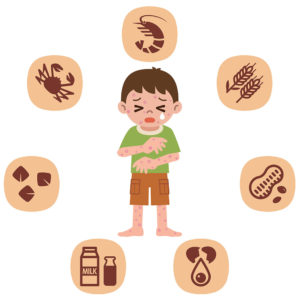ANAPHYLAXIS

Anaphylaxis is a serious, life-threatening allergic reaction. In most cases, the onset of anaphylaxis symptoms is quickly seen, within 5-30 minutes after being exposed to the allergy-triggering substance, called allergen.
In an anaphylactic response, the immune system – responsible for protecting our body – shows an exaggerated reaction to a given substance (which is harmless for most people), causing anaphylaxis. The most common causes of anaphylaxis are food, insect bites, and drugs.
Anaphylaxis – Main Causes
| food | Milk, eggs, fish, peanuts, sea food, nuts, wheat |
| insect bites | Wasp, bee, ant |
| drugs | Antibiotics (penicillin and amoxicillin), non-steroidal anti-inflammatory drugs (acetyl salicylic acid, diclofenac, ibuprofen), anticonvulsants, monoclonal antibodies, pain relief and chemotherapy agents |
| other | latex, exercise-induced anaphylaxis |
| unknown causes |
In an anaphylactic response, several organs may be compromised, causing different symptoms that will determine response’s degree of severity (from mild to very severe):
- Skin symptoms (occurring in 90% of the cases) –redness, itching, urticaria and/or angioedema
- Respiratory system – itchy nose, dry cough, hoarseness, throat and chess tightness, and/or difficult breathing
- Gastrointestinal tract – nausea, vomiting, abdominal pain, and/or diarrhea
- Central nervous system – dizziness, mental confusion, fainting sensation, unconsciousness
- Cardiovascular system – reduced blood pressure and tachycardia (fast heart beating)
When patients’ cardiovascular and neurologic systems are affected with reduced blood pressure, unconsciousness, or, also, edema of the glottis with suffocation, anaphylaxis is called anaphylactic shock, which represents an extremely serious condition.
Anaphylaxis is a medical emergency and therapy must be implemented right after diagnosis is established. The first line of treatment consists of keeping respiratory system and blood flow working, in addition to adrenaline injection.
After discharged from emergency, an anaphylaxis patient must be referred to a specialist, who will take a detailed history, and make clinical and laboratory tests, if required.
Patients must receive clear guidance on what to do in order to avoid a new episode or how to proceed in case of a new flare:
- Avoid being exposed to previously known causes;
- Always carry a pre-filled injection of adrenaline, and learn when and how to use it (this is an imported syringe, and your doctor should guide you on where to find it);
- Promptly seek emergency medical care;
- Keep documents or wear bracelets describing the substances to which you are allergic.
These are critical steps for anyone who had ever experienced an anaphylaxis episode, because these patients are more likely to have recurrences.
And don’t forget: anaphylaxis is a serious reaction

References:
J Allergy Clin Immunol 2015; 135:1125-31
Postgrad Med J 2012; 88:458-464






